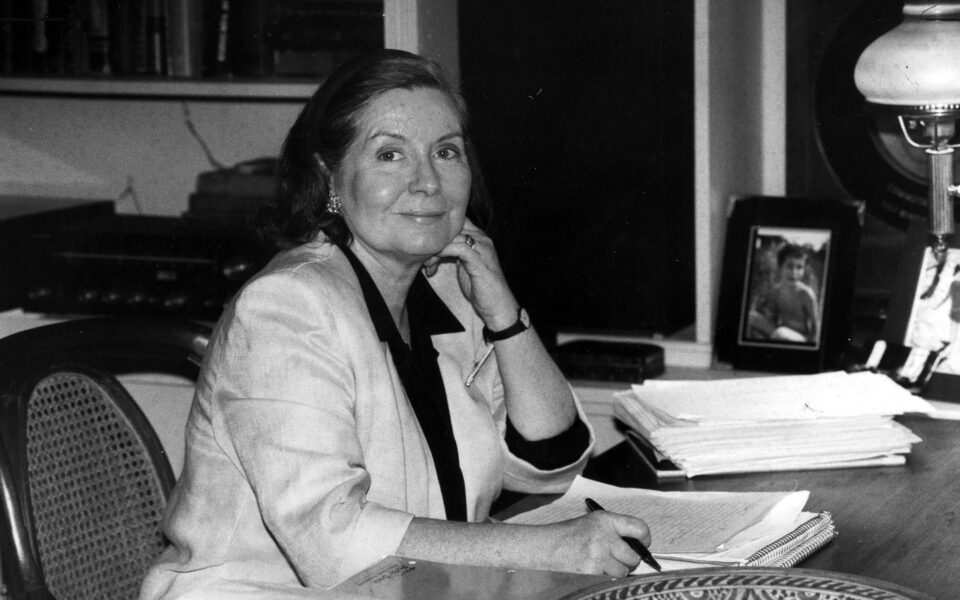Maureen Howard, novelist who traced women’s challenges, dies at 91

Maureen Howard, who first drew wide attention in 1965 with her novel “Bridgeport Bus,” which came to be regarded as a precursor to second-wave feminism, and went on to write ambitious, well-regarded books for 45 more years, died Sunday in the New York City borough of Manhattan. She was 91.
Her daughter, Loretta Howard, confirmed the death.
Howard’s novels, some of which took Irish American assimilation as a theme, often featured women confronting challenges in marriage and society. Three successive midcareer works, “Grace Abounding” (1982), “Expensive Habits” (1986) and “Natural History” (1992), were finalists for the prestigious PEN/Faulkner Award.
Her final four books, as she described them, were thematically a seasonal quartet – first winter with “A Lover’s Almanac” (1998), then spring with “Big as Life” (2001), summer with “The Silver Screen” (2004) and, finally, autumn with “The Rags of Time” (2009). Paul Slovak, her editor on those four books, which were published by Viking, said by email that Howard’s works “featured an ambitious interplay of history, politics, art and life as they tracked the stories of families and especially of spirited, formidable women, providing a broad take on American life over the last 60 years.”
Howard, who also taught at Princeton, Yale and other institutions over the years, was in her early 30s when she published her first novel, “Not a Word About Nightingales,” in 1962. “Bridgeport Bus,” three years later, was about a 35-year-old virgin named Mary Agnes who lives with her mother, not particularly happily:
“When I go home my mother and I play a cannibal game; we eat each other over the years, tender morsel by morsel until there is nothing left but dry bone and wig.”
Mary Agnes breaks away, taking a bus from Bridgeport, Connecticut, where she lives (and where Howard grew up), to New York on a journey of self-discovery that has highs and lows.
“Whether comedy or tragedy, the individual reader must decide,” Catherine Brown wrote in a review in The Courier-Journal of Louisville, Kentucky, “but no one is going to find this book dull.”
In 2001, John Leonard, writing in The New York Times about “Big as Life,” noted the ahead-of-its-time quality of “Bridgeport Bus,” calling it “a ‘Fear of Flying’ before the feminist resurgence.”
In “Bridgeport Bus” Howard played with narrative forms, something that was to become characteristic of her work.
“What I’m trying to do is to break away from the dictate that says the modern novel must follow a certain singular form,” she told The Asbury Park Press of New Jersey in 1965. “Why does the novel have to be like a play in which all the characters come out to the center of the stage in a certain prescribed manner, speak their lines in a certain prescribed way, and then exit in that same prescribed way?”
Novelist Richard Powers was a fan and one of a number of writers who benefited from Howard’s career guidance.
“Maureen Howard was a bold, adventurous writer of the first rank who loved the idea of making the novel do and hold more,” he said by email. “Her fiction was innovative and exploratory, but it was also intimate, personal and vivid.”
Even her 1978 autobiographical work, “Facts of Life,” which won a National Book Critics Circle Award for nonfiction, avoided the traditional chronology. It was divided into three sections: “Culture,” “Money” and “Sex.”
Howard put a lot of research into her fiction; she attended Human Rights Watch meetings to learn about children in armed conflicts, for example, and an economics conference to see the relationship between economic theories and real-world challenges. “Big as Life,” which consisted of three novellas, touched on ornithology, the history of medicine and advanced mathematics, and she studied up on all of them.
“It’s not that I simply wanted to plant mathematics in the story,” she told The Star Tribune of Minneapolis in 2001. “It’s because of the supposed certainty of mathematics and the uncertainty of life. That’s what I’m interested in.”
As Powers put it, “I always thought of her as a kind of Smithsonian, recreating America of the 20th century through collecting and curating endlessly resonant, dense details.”
Novelist Paul Auster developed a friendship with Howard when both taught at Princeton in the mid-1980s and would ride the train back to New York together.
“I really admired her work because of the combination of rigor and imagination and acuity,” he said in a phone interview. “She was interested in everything. She was curious and alive and not content to just do what other people did.”
Maureen Theresa Kearns was born June 28, 1930, in Bridgeport into an Irish Catholic household. Her mother, Loretta (Burns) Kearns, was a teacher and an artist; her father, William, was a police detective.
Bridgeport’s most famous resident may have been the circus impresario P.T. Barnum, who was the mayor there briefly in the 1870s, and Howard, who used the city in her novels, was well aware of its reputation.
“Bridgeport was a vaudeville joke,” she told The Times in 1991. “P.T. Barnum invited a kind of not only adulation, but laughter and mockery.”
She attended Lauralton Hall, a Roman Catholic school in nearby Milford, Connecticut, where she was somewhat rebellious.
“On one occasion, I painted the toenails of a St. Joseph statue bright Revlon red,” she told The Boston Globe in 1986. “I was straining at the bit. I said to myself, ‘Hey, the world can’t be this tiny.’ ”
Howard graduated from Smith College in 1952. She then held jobs in publishing and advertising and soon married Daniel Howard, who would become an English professor at Rutgers University.
Their marriage ended in divorce, as did her second, to David Gordon. In 1981, Howard, who lived in Manhattan, married Mark Probst, a stockbroker. He died in 2018. In addition to her daughter, who is from her first marriage, she is survived by two grandchildren.
If Howard’s books were not blockbusters, they were often well received by critics. Gail Caldwell, reviewing “A Lover’s Almanac” in 1998 in The Boston Globe, said it had “as much brain power per square inch as a dictionary.”
The book begins with a troubled love affair in premillennial New York, then branches through time in an exploration of fate and happenstance. Caldwell wrote that the novel’s real connective tissue “is the authorial intelligence, roving with a kind of sweet insouciance among science and art, past and future, as though Maureen Howard were simply killing a Sunday morning at a flea market of ideas.”
This article originally appeared in The New York Times.






